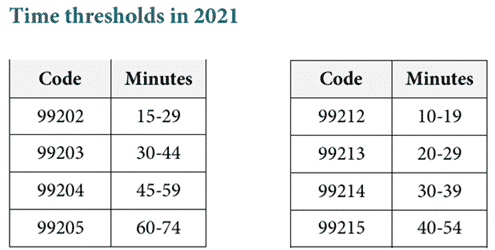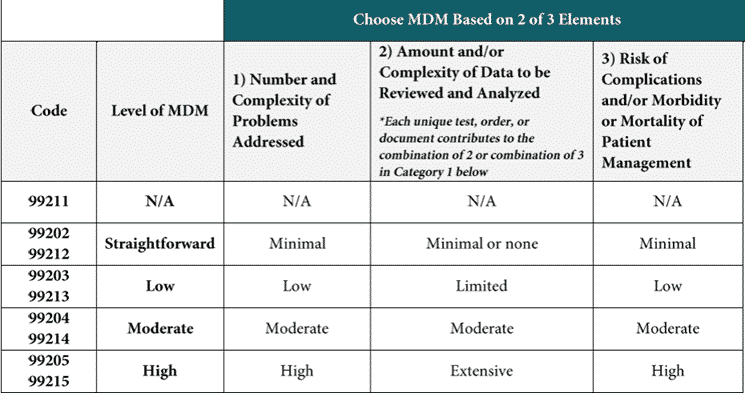Medical Decision Making TIP #5
MDM Tip #5
The second element of MDM in 2021
The 2nd (of 3) elements of MDM: amount and/or complexity of data to be reviewed and analyzed at the encounter
E/M changes for 2021 for codes 99202—99215
- There are three elements in medical decision-making and this article describes the second, arguably, the most complex of the three elements
- When selecting a level of service based on medical decision-making two of the three elements are required
- CPT® has developed definitions for many of the components in the MDM chart and this article describes the definitions and rules related to data
Definitions related to data in the new MDM chart for office E/M visits in 2021
This article will start with the definitions and then describe how to select the level of data in the chart.
The CPT® definitions are in italics, my comments are not.
Test: Tests are imaging, laboratory, psychometric, or physiologic data. A clinical laboratory panel (eg, basic metabolic panel [80047]) is a single test. The differentiation between single or multiple unique tests is defined in accordance with the CPT code set.
- A panel of lab tests is considered a single, unique test.
- Lab tests with their own CPT® code are considered unique tests. A mono-spot and a quick strep test each have their own CPT® codes; if ordered, those would be two unique tests.
- There is separate counting for ordering and for reviewing the unique test.
- Tests included lab tests, in the 80000 series of codes.
- Tests include diagnostic tests, in the 70000 series of codes
- Tests include the medical tests in the medicine chapter, in the 90000 series of codes.
External: External records, communications and/or test results are from an external physician, other qualified health care professional, facility or healthcare organization.
- Records from another clinician or facility.
External physician or other qualified healthcare professional: An external physician or other qualified health care professional is an individual who is not in the same group practice or is a different specialty or subspecialty. It includes licensed professionals that are practicing independently. It may also be a facility or organizational provider such as a hospital, nursing facility, or home health care agency.
- When the data section discusses review of external records, count records from a physician/NP/PA within your multi-specialty group, but who has a different specialty are considered
- Don’t include records from your same specialty partners.
Independent historian(s): An individual (eg, parent, guardian, surrogate, spouse, witness) who provides a history in addition to a history provided by the patient who is unable to provide a complete or reliable history (eg, due to developmental stage, dementia, or psychosis) or because a confirmatory history is judged to be necessary. In the case where there may be conflict or poor communication between multiple historians and more than one historian(s) is needed, the independent historian(s) requirement is met.
- This specifically includes parents. Parents of pediatric patients who are unable to give a history are counted as independent historians. “Developmental stage” is specifically included.
- Whether there is one or multiple historians, count this once.
- This is history obtained from a parent, guardian, surrogate, spouse or witness, not another health care professional.
Independent Interpretation: The interpretation of a test for which there is a CPT® code and an interpretation or report is customary. This does not apply when the physician or other qualified health care professional is reporting the service or has previously reported the service for the patient. A form of interpretation should be documented, but need not conform to the usual standards of a complete report for the test.
- If the clinician interprets a diagnostic test, but is not billing for that test, credit an independent interpretation, within these parameters:
- There is typically an interpretation or report for that test, and
- The clinician did not bill for the interpretation at a prior encounter.
- A surgeon reviews a mammogram and compares it to the mammogram from the prior year. The surgeon did not bill for the interpretation of either image.
- An orthopedist reviews the MRI that was interpreted and billed by a radiologist.
- A “separate” report is not required, but the clinician should note their interpretation of the image/tracing.
Appropriate source: For the purpose of the Discussion of Management data element, an appropriate source includes professionals who are not health care professionals, but may be involved in the management of the patient (eg, lawyer, parole officer, case manager, teacher). It does not include discussion with family or informal caregivers.
Selecting the level of data using the new MDM chart for E/M services in 2021
The most difficult of the three elements to score is the data element, the middle column of the chart. Data is defined as minimal or none, limited, moderate and extensive. Except for minimal or no data, data is divided into three categories. (Be sure to have the one-page MDM chart in front of you while looking at this.)
- Category 1: Tests and documents
- Category 2: Assessment requiring an independent historian
- Category 3: Discussion of management or test interpretation
99203 and 99213 requires one of the two categories (Category 1 or Category 2) to meet the data requirement of limited.
99204 and 99214 requires one of three of categories (Category 1, Category 2 or Category 3) to meet the requirement of moderate.
99205 and 99215 requires two of three categories (Category 1, Category 2 or Category 3 to meet the requirement of extensive.
Now, the definitions that the AMA has developed come in handy as we assess:
99203 and 99213:
Limited
(Must meet the requirements of at least 1 of the 2 categories)
Category 1: Tests and documents
Any combination of 2 from the following:
- Review of prior external note(s) from each unique source*;
- review of the result(s) of each unique test*;
- ordering of each unique test*
or
Category 2: Assessment requiring an independent historian(s)
(For the categories of independent interpretation of tests and discussion of management or test interpretation, see moderate or high)
99204 and 99214:
Moderate
(Must meet the requirements of at least 1 out of 3 categories)
Category 1: Tests, documents, or independent historian(s) • Any combination of 3 from the following:
- Review of prior external note(s) from each unique source*;
- Review of the result(s) of each unique test*;
- Ordering of each unique test*;
- Assessment requiring an independent historian(s)
or
Category 2: Independent interpretation of tests
- Independent interpretation of a test performed by another physician/other qualified health care professional (not separately reported);
or
Category 3: Discussion of management or test interpretation
- Discussion of management or test interpretation with external physician/other qualified health care professional appropriate source (not separately reported)
99205 and 99215:
Extensive
(Must meet the requirements of at least 2 out of 3 categories)
Category 1: Tests, documents, or independent historian(s) • Any combination of 3 from the following:
- Review of prior external note(s) from each unique source*;
- Review of the result(s) of each unique test*;
- Ordering of each unique test*;
- Assessment requiring an independent historian(s)
or
Category 2: Independent interpretation of tests
- Independent interpretation of a test performed by another physician/other qualified health care professional (not separately reported);
or
Category 3: Discussion of management or test interpretation
- Discussion of management or test interpretation with external physician/other qualified health care professional/appropriate source (not separately reported)


